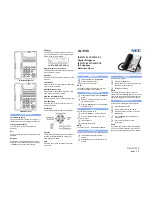
For Your Safety
153
3. What kinds of devices are the subject of this update?
The term “wireless device” refers here to handheld wireless devices with built-in
antennas, often called “cell,” “mobile,” or “PCS” devices. These types of wireless
devices can expose the user to measurable Radio Frequency (RF) energy because
of the short distance between the device and the user’s head.
These RF exposures are limited by FCC safety guidelines that were developed with
the advice of the FDA and other federal health and safety agencies. When the
device is located at greater distances from the user, the exposure to RF is drastically
lower because a person’s RF exposure decreases rapidly with increasing distance
from the source. The so-called “cordless devices,” which have a base unit connected
to the telephone wiring in a house, typically operate at far lower power levels, and
thus produce RF exposures far below the FCC safety limits.
4. What are the results of the research done already?
The research done thus far has produced conflicting results, and many studies have
suffered from flaws in their research methods. Animal experiments investigating
the effects of Radio Frequency (RF) energy exposures characteristic of wireless
devices have yielded conflicting results that often cannot be repeated in other
laboratories. A few animal studies, however, have suggested that low levels of RF
could accelerate the development of cancer in laboratory animals. However, many
of the studies that showed increased tumor development used animals that had
been genetically engineered or treated with cancer-causing chemicals so as to
be pre-disposed to develop cancer in the absence of RF exposure. Other studies
exposed the animals to RF for up to 22 hours per day. These conditions are not
similar to the conditions under which people use wireless devices, so we do not
know with certainty what the results of such studies mean for human health. Three
large epidemiology studies have been published since December 2000. Between
them, the studies investigated any possible association between the use of wireless
devices and primary brain cancer, glioma, meningioma, or acoustic neuroma, tumors
of the brain or salivary gland, leukemia, or other cancers. None of the studies
demonstrated the existence of any harmful health effects from wireless device RF
exposures. However, none of the studies can answer questions about long-term
exposures, since the average period of device use in these studies was around three
years.
Summary of Contents for Stylo 6
Page 6: ...Custom designed Features 01 ...
Page 22: ...Basic Functions 02 ...
Page 57: ...Useful Apps 03 ...
Page 93: ...Settings 04 ...
Page 121: ...Appendix 05 ...
Page 136: ...For Your Safety 06 ...
Page 161: ...LIMITED WARRANTY USA 07 ...
Page 168: ......















































